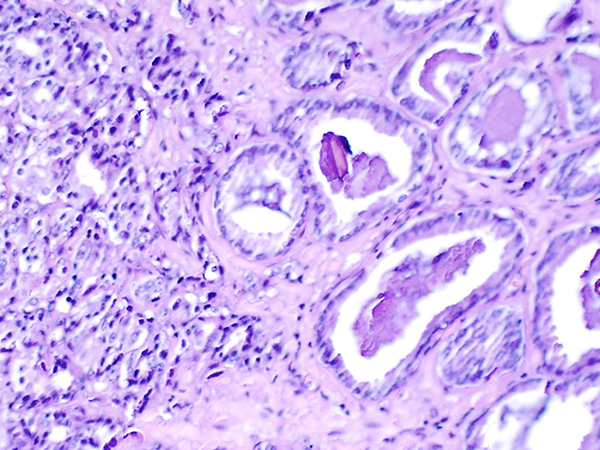Editors’ Picks, March 2024: Synergy’s Impact on Resistance, New Early Detection Tools, and More
What’s the downside of synergistic drug combinations? Can aggressive cancers be caught early? How does stress impact the gut microbiome?
This month, the editors of the American Association for Cancer Research’s (AACR) 10 peer-reviewed journals have highlighted studies that address these questions and others. Take a look below for the abstract of each featured study, and follow the links to the full articles—freely available for a limited time.
Journal: Blood Cancer Discovery
Synergistic Drug Combinations Promote the Development of Resistance in Acute Myeloid Leukemia
Combination therapy is an important part of cancer treatment and is often employed to overcome or prevent drug resistance. Preclinical screening strategies often prioritize synergistic drug combinations; however, studies of antibiotic combinations show that synergistic drug interactions can accelerate the emergence of resistance because resistance to one drug depletes the effect of both. In this study, we aimed to determine whether synergy drives the development of resistance in cancer cell lines using live-cell imaging. Consistent with prior models of tumor evolution, we found that when controlling for activity, drug synergy is associated with increased probability of developing drug resistance. We demonstrate that these observations are an expected consequence of synergy: the fitness benefit of resisting a drug in a combination is greater in synergistic combinations than in nonsynergistic combinations. These data have important implications for preclinical strategies aiming to develop novel combinations of cancer therapies with robust and durable efficacy.
Significance: Preclinical strategies to identify combinations for cancer treatment often focus on identifying synergistic combinations. This study shows that in AML cells combinations that rely on synergy can increase the likelihood of developing resistance, suggesting that combination screening strategies may benefit from a more holistic approach rather than focusing on drug synergy.
This article was highlighted in the March issue. A related commentary can be found here.
Journal: Cancer Discovery

Noninvasive Detection of Neuroendocrine Prostate Cancer through Targeted Cell-free DNA Methylation
Castration-resistant prostate cancer (CRPC) is a heterogeneous disease associated with phenotypic subtypes that drive therapy response and outcome differences. Histologic transformation to castration-resistant neuroendocrine prostate cancer (CRPC-NE) is associated with distinct epigenetic alterations, including changes in DNA methylation. The current diagnosis of CRPC-NE is challenging and relies on metastatic biopsy. We developed a targeted DNA methylation assay to detect CRPC-NE using plasma cell-free DNA (cfDNA). The assay quantifies tumor content and provides a phenotype evidence score that captures diverse CRPC phenotypes, leveraging regions to inform transcriptional state. We tested the design in independent clinical cohorts (n = 222 plasma samples) and qualified it achieving an AUC > 0.93 for detecting pathology-confirmed CRPC-NE (n = 136). Methylation-defined cfDNA tumor content was associated with clinical outcomes in two prospective phase II clinical trials geared towards aggressive variant CRPC and CRPC-NE. These data support the application of targeted DNA methylation for CRPC-NE detection and patient stratification.
Significance: Neuroendocrine prostate cancer is an aggressive subtype of treatment-resistant prostate cancer. Early detection is important, but the diagnosis currently relies on metastatic biopsy. We describe the development and validation of a plasma cell–free DNA targeted methylation panel that can quantify tumor fraction and identify patients with neuroendocrine prostate cancer noninvasively.
This article was highlighted and featured on the cover of the March issue.
Journal: Cancer Epidemiology, Biomarkers & Prevention
Background: The association between childhood cancer risk and maternal prenatal substance use/abuse remains uncertain due to modest sample sizes and heterogeneous study designs.
Methods: We surveyed parents of children with cancer regarding maternal gestational use of tobacco, alcohol, and illicit drugs, using a Likert-type scale, and demographic, perinatal, and clinical variables. Multivariable log-Poisson regression assessed differences in frequency of prenatal substance use across fifteen childhood cancer subtypes, adjusting for birthweight, gestational age, and demographic factors.
Results: Respondents from 3,145 unique families completed the survey (92% biological mothers). A minority reported gestational use of tobacco products (14%), illicit drugs including marijuana or cocaine (4%), or more than a moderate amount of alcohol (2%). Prenatal illicit drug use was associated with increased prevalence of intracranial embryonal tumors [prevalence ratio (PR) = 1.94; confidence interval [CI], 1.05–3.58], including medulloblastoma (PR = 1.82) and supratentorial primitive neuroectodermal tumors (PNET; PR = 2.66), and was also associated with retinoblastoma (PR = 3.11; CI, 1.20–8.08). Moderate to heavy alcohol consumption was strongly associated with elevated prevalence of non-Hodgkin lymphoma (PR = 5.94; CI, 1.84–19.21). Prenatal smoking was not associated with elevated prevalence of any childhood cancer subtype.
Conclusions: We identify novel associations between illicit drug use during pregnancy and increased prevalence of nonglioma central nervous system tumors, including medulloblastoma, supratentorial PNETs, and retinoblastoma. Gestational exposure to alcohol was positively associated with non-Hodgkin lymphoma.
Impact: Although alcohol and tobacco use during pregnancy has declined, gestational cannabis use has risen. Investigating its impact on neurodevelopment and brain tumorigenesis is vital, with important implications for childhood cancer research and public health education.
This article was highlighted in the March issue.
Journal: Cancer Immunology Research
Colitis induced by treatment with immune-checkpoint inhibitors (ICI), termed irColitis, is a substantial cause of morbidity complicating cancer treatment. We hypothesized that abnormal fecal microbiome features would be present at the time of irColitis onset and that restoring the microbiome with fecal transplant from a healthy donor would mitigate disease severity. Herein, we present fecal microbiota profiles from 18 patients with irColitis from a single center, 5 of whom were treated with healthy-donor fecal microbial transplantation (FMT). Although fecal samples collected at onset of irColitis had comparable α-diversity to that of comparator groups with gastrointestinal symptoms, irColitis was characterized by fecal microbial dysbiosis. Abundances of Proteobacteria were associated with irColitis in multivariable analyses. Five patients with irColitis refractory to steroids and biologic anti-inflammatory agents received healthy-donor FMT, with initial clinical improvement in irColitis symptoms observed in four of five patients. Two subsequently exhibited recurrence of irColitis symptoms following courses of antibiotics. Both received a second “salvage” FMT that was, again, followed by clinical improvement of irColitis. In summary, we observed distinct microbial community changes that were present at the time of irColitis onset. FMT was followed by clinical improvements in several cases of steroid- and biologic-agent-refractory irColitis. Strategies to restore or prevent microbiome dysbiosis in the context of immunotherapy toxicities should be further explored in prospective clinical trials.
The study was featured on the cover of the March issue.

Journal: Cancer Prevention Research
The multi-target stool DNA (mt-sDNA) test screens for colorectal cancer by analyzing DNA methylation/mutation and hemoglobin markers to algorithmically derive a qualitative result. A new panel of highly discriminant candidate methylated DNA markers (MDM) was recently developed. Performance of the novel MDM panel, with hemoglobin, was evaluated in a simulated screening population using archived stool samples weighted to early-stage colorectal cancer and prospectively collected advanced precancerous lesions (APL). Marker selection study (MSS) and separate preliminary independent verification studies (VS) were conducted utilizing samples from multi-center, case–control studies. Sample processing included targeted MDM capture, bisulfite conversion, and MDM quantitation. Fecal hemoglobin was quantified using ELISA. Samples were stratified into 75%/25% training-testing sets; model outcomes were cross-validated 1,000 times. All laboratory operators were blinded. The MSS included 232 cases (120 colorectal cancer/112 APLs) and 490 controls. The VS featured 210 cases (112 colorectal cancer/98 APLs) and 567 controls; APLs were 86.7% adenomas and 13.3% sessile serrated lesions (SSL). Average age was 65.5 (cases) and 63.2 (controls) years. Mean sensitivity in the VS from cross-validation was 95.2% for colorectal cancer and 57.2% for APLs, with specificities of 89.8% (no CRC/APLs) and 92.4% (no neoplasia). Subgroup analyses showed colorectal cancer sensitivities of 93.4% (stage I) and 94.2% (stage II). APL sensitivity was 82.9% for high-grade dysplasia, 73.4% for villous lesions, 49.8% for tubular lesions, and 30.2% for SSLs. These data support high sensitivity and specificity for a next-generation mt-sDNA test panel. Further evaluation of assay performance will be characterized in a prospective, multi-center clinical validation study (NCT04144738).
Prevention Relevance: This study highlights performance of the next-generation mt-sDNA test, which exhibits high sensitivity and specificity for detecting colorectal cancer and APLs. This noninvasive option has potential to increase screening participation and clinical outcomes. A multi-center, clinical validation trial is underway.
This article was featured on the cover of the March issue. A related commentary can be found here.
Journal: Cancer Research (March 1 issue)
Colorectal cancer development and outcome are impacted by modifiable risk factors, including psychologic stress. The gut microbiota has also been shown to be linked to psychologic factors. Here, we found a marked deteriorative effect of chronic stress in multiple colorectal cancer models, including chemically induced (AOM/DSS), genetically engineered (APCmin/+), and xenograft tumor mouse models. RNA sequencing data from colon tissues revealed that expression of stemness-related genes was upregulated in the stressed colorectal cancer group by activated β-catenin signaling, which was further confirmed by results from ex vivo organoid analyses as well as in vitro and in vivo cell tumorigenicity assays. 16S rRNA sequencing of the gut microbiota showed that chronic stress disrupted gut microbes, and antibiotic treatment and fecal microbiota transplantation abolished the stimulatory effects of chronic stress on colorectal cancer progression. Stressed colorectal cancer mice displayed a significant decrease in Lactobacillus johnsonii (L. johnsonii) abundance, which was inversely correlated with tumor load. Moreover, protocatechuic acid (PCA) was identified as a beneficial metabolite produced by L. johnsonii based on metabolome sequencing and LC/MS-MS analysis. Replenishment of L. johnsonii or PCA blocked chronic stress-induced colorectal cancer progression by decreasing β-catenin expression. Furthermore, PCA activated the cGMP pathway, and the cGMP agonist sildenafil abolished the effects of chronic stress on colorectal cancer. Altogether, these data identify that stress impacts the gut microbiome to support colorectal cancer progression.
Significance: Chronic stress stimulates cancer stemness by reducing the intestinal abundance of L. johnsonii and its metabolite PCA to enhance β-catenin signaling, forming a basis for potential strategies to circumvent stress-induced cancer aggressiveness.
A related commentary can be found here.
Journal: Cancer Research (March 15 issue)
AKT1 interacts with DHX9 to Mitigate R Loop–Induced Replication Stress in Ovarian Cancer
PARP inhibitor (PARPi)–resistant BRCA-mutant (BRCAm) high-grade serous ovarian cancer (HGSOC) represents a new clinical challenge with unmet therapeutic needs. Here, we performed a quantitative high-throughput drug combination screen that identified the combination of an ATR inhibitor (ATRi) and an AKT inhibitor (AKTi) as an effective treatment strategy for both PARPi-sensitive and PARPi-resistant BRCAm HGSOC. The ATRi and AKTi combination induced DNA damage and R loop–mediated replication stress (RS). Mechanistically, the kinase domain of AKT1 directly interacted with DHX9 and facilitated recruitment of DHX9 to R loops. AKTi increased ATRi-induced R loop–mediated RS by mitigating recruitment of DHX9 to R loops. Moreover, DHX9 was upregulated in tumors from patients with PARPi-resistant BRCAm HGSOC, and high coexpression of DHX9 and AKT1 correlated with worse survival. Together, this study reveals an interaction between AKT1 and DHX9 that facilitates R loop resolution and identifies combining ATRi and AKTi as a rational treatment strategy for BRCAm HGSOC irrespective of PARPi resistance status.
Significance: Inhibition of the AKT and ATR pathways cooperatively induces R loop–associated replication stress in high-grade serous ovarian cancer, providing rationale to support the clinical development of AKT and ATR inhibitor combinations.
A related commentary can be found here.
Journal: Clinical Cancer Research (March 1 issue)
Purpose: Bintrafusp alfa, a first-in-class bifunctional fusion protein composed of the extracellular domain of TGFβ receptor II (a TGFβ “trap”) fused to a human IgG1 mAb blocking programmed death-ligand 1 (PD-L1), was evaluated as treatment in patients with locally advanced or persistent, recurrent, or metastatic (P/R/M) cervical cancer.
Patients and Methods: In this multicenter, open-label, phase Ib trial (NCT04551950), patients with P/R/M cervical cancer received bintrafusp alfa 2,400 mg once every 3 weeks plus cisplatin or carboplatin plus paclitaxel with (Cohort 1A; n = 8) or without (Cohort 1B; n = 9) bevacizumab; patients with locally advanced cervical cancer received bintrafusp alfa 2,400 mg every 3 weeks plus cisplatin plus radiation, followed by bintrafusp alfa monotherapy maintenance (Cohort 2; n = 8). The primary endpoint was safety; secondary endpoints included efficacy (including objective response rate) and pharmacokinetics.
Results: At the data cutoff of April 27, 2022, patients in Cohorts 1A, 1B, and 2 had received bintrafusp alfa for a median duration of 37.9, 31.1, and 16.7 weeks, respectively. Two dose-limiting toxicities (grade 4 amylase elevation and grade 3 menorrhagia) unrelated to bintrafusp alfa were observed in Cohort 1B and none in other cohorts. Most treatment-emergent adverse events of special interest were grades 1–2 in severity, most commonly anemia (62.5%–77.8%) and bleeding events (62.5%–77.8%). Objective response rate was 75.0% [95% confidence interval (CI), 34.9–96.8], 44.4% (95% CI, 13.7–78.8), and 62.5% (95% CI, 24.5–91.5) in Cohorts 1A, 1B, and 2, respectively.
Conclusions: Bintrafusp alfa had manageable safety and demonstrated clinical activity, further supporting the investigation of TGFβ/PD-L1 inhibition in human papillomavirus–associated cancers, including cervical cancer.
This article was highlighted in the March 1 issue.
Journal: Clinical Cancer Research (March 15 issue)
Purpose: Concurrent chemoradiotherapy (CCRT) followed by durvalumab consolidation for up to 12 months is the standard of care for patients with unresectable stage III non–small cell lung cancer (NSCLC). However, exactly when to initiate durvalumab therapy after chemoradiation completion remains unknown. We evaluated the efficacy and safety of durvalumab, administered immediately after CCRT completion, for patients with unresectable stage III NSCLC.
Patients and Methods: This study was a prospective, single-arm, open-label phase II clinical trial. Patients without disease progression after definitive CCRT (two cycles of platinum-based doublet chemotherapy with 60 Gy/30 Fr radiotherapy) received durvalumab (every 2 weeks for up to 12 months) from the next day (up to 5 days) after the final radiation dose. The primary endpoint was the 1-year progression-free survival (PFS) from registration before the start of CCRT.
Results: From January 2020 to August 2020, 47 of 50 enrolled patients were evaluable for treatment efficacy and safety. The 1-year PFS from registration was 75.0% [60% confidence interval (CI), 69.0–80.0 and 95% CI, 59.4–85.3]. The objective response rate throughout the study treatment and median PFS from registration were 78.7% and 14.2 months (95% CI, 13.4 to not reached), respectively. Grade 3/4 pneumonitis and febrile neutropenia were each 4.3%.
Conclusions: Our study met the primary endpoint. The incidence of pneumonitis was similar to that of a Japanese subset in the PACIFIC study. Our data support the efficacy and safety of durvalumab administered immediately after the completion of CCRT for patients with unresectable stage III NSCLC.
This article was highlighted in the March 15 issue.
Journal: Molecular Cancer Research
FGFR1 Signaling Facilitates Obesity-Driven Pulmonary Outgrowth in Metastatic Breast Cancer
Survival of dormant, disseminated breast cancer cells contributes to tumor relapse and metastasis. Women with a body mass index greater than 35 have an increased risk of developing metastatic recurrence. Herein, we investigated the effect of diet-induced obesity (DIO) on primary tumor growth and metastatic progression using both metastatic and systemically dormant mouse models of breast cancer. This approach led to increased PT growth and pulmonary metastasis. We developed a novel protocol to induce obesity in Balb/c mice by combining dietary and hormonal interventions with a thermoneutral housing strategy. In contrast to standard housing conditions, ovariectomized Balb/c mice fed a high-fat diet under thermoneutral conditions became obese over a period of 10 weeks, resulting in a 250% gain in fat mass. Obese mice injected with the D2.OR model developed macroscopic pulmonary nodules compared with the dormant phenotype of these cells in mice fed a control diet. Analysis of the serum from obese Balb/c mice revealed increased levels of FGF2 as compared with lean mice. We demonstrate that serum from obese animals, exogenous FGF stimulation, or constitutive stimulation through autocrine and paracrine FGF2 is sufficient to break dormancy and drive pulmonary outgrowth. Blockade of FGFR signaling or specific depletion of FGFR1 prevented obesity-associated outgrowth of the D2.OR model.
Implications: Overall, this study developed a novel DIO model that allowed for demonstration of FGF2:FGFR1 signaling as a key molecular mechanism connecting obesity to breakage of systemic tumor dormancy and metastatic progression.
This article was highlighted in the March issue.
Journal: Molecular Cancer Therapeutics
Cadherin-6 (CDH6) is expressed in several cancer types, but no CDH6-targeted therapy is currently clinically available. Here, we generated raludotatug deruxtecan (R-DXd; DS-6000), a novel CDH6-targeting antibody–drug conjugate with a potent DNA topoisomerase I inhibitor, and evaluated its properties, pharmacologic activities, and safety profile. In vitro pharmacologic activities and the mechanisms of action of R-DXd were assessed in serous-type ovarian cancer and renal cell carcinoma cell lines. In vivo pharmacologic activities were evaluated with several human cancer cell lines and patient-derived xenograft mouse models. The safety profile in cynomolgus monkeys was also assessed. R-DXd exhibited CDH6 expression-dependent cell growth-inhibitory activity and induced tumor regression in xenograft models. In this process, R-DXd specifically bound to CDH6, was internalized into cancer cells, and then translocated to the lysosome. The DXd released from R-DXd induced the phosphorylation of Chk1, a DNA damage marker, and cleaved caspase-3, an apoptosis marker, in cancer cells. It was also confirmed that the DXd payload had a bystander effect, passing through the cell membrane and impacting surrounding cells. The safety profile of R-DXd was favorable and the highest non-severely toxic dose was 30 mg/kg in cynomolgus monkeys. R-DXd demonstrated potent antitumor activity against CDH6-expressing tumors in mice and an acceptable safety profile in monkeys. These findings indicate the potential of R-DXd as a new treatment option for patients with CDH6-expressing serous-type ovarian cancer and renal cell carcinoma in a clinical setting.
This article was highlighted and featured on the cover of the March issue.

Journal: Cancer Research Communications
Estrogen receptor–positive (ER+) breast cancer is not considered immunogenic and, to date, has been proven resistant to immunotherapy. Endocrine therapy remains the cornerstone of treatment for ER+ breast cancers. However, constitutively activating mutations in the estrogen receptor alpha (ESR1) gene can emerge during treatment, rendering tumors resistant to endocrine therapy. Although these mutations represent a pathway of resistance, they also represent a potential source of neoepitopes that can be targeted by immunotherapy. In this study, we investigated ESR1 mutations as novel targets for breast cancer immunotherapy. Using machine learning algorithms, we identified ESR1-derived peptides predicted to form stable complexes with HLA-A*0201. We then validated the binding affinity and stability of the top predicted peptides through in vitro binding and dissociation assays and showed that these peptides bind HLA-A*0201 with high affinity and stability. Using tetramer assays, we confirmed the presence and expansion potential of antigen-specific CTLs from healthy female donors. Finally, using in vitro cytotoxicity assays, we showed the lysis of peptide-pulsed targets and breast cancer cells expressing common ESR1 mutations by expanded antigen-specific CTLs. Ultimately, we identified five peptides derived from the three most common ESR1 mutations (D538G, Y537S, and E380Q) and their associated wild-type peptides, which were the most immunogenic. Overall, these data confirm the immunogenicity of epitopes derived from ESR1 and highlight the potential of these peptides to be targeted by novel immunotherapy strategies.
Significance: Estrogen receptor (ESR1) mutations have emerged as a key factor in endocrine therapy resistance. We identified and validated five novel, immunogenic ESR1-derived peptides that could be targeted through vaccine-based immunotherapy.



